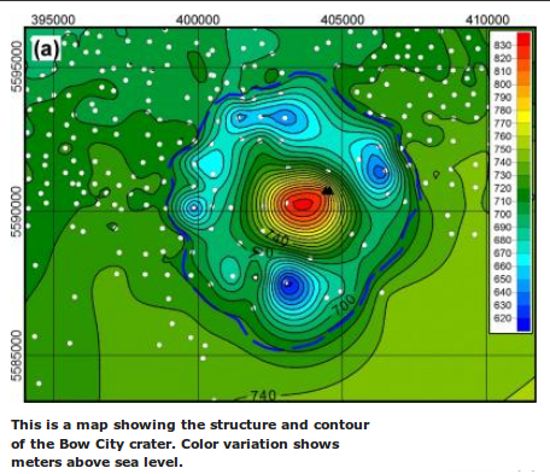Researchers with the University of Alberta in Canada say that, according to evidence at hand, present-day southern Alberta had a really close encounter with a meteorite sometime within the past 70 million years.
They say that, sometime in history, the region was struck by a meteorite that left behind a crater measuring about 8 kilometers (5 miles) across, just so that southern Alberta would have something to remember it by.
Specialists with the University of Alberta first started suspecting that this region got hit by a meteorite many years ago, after documenting the existence of a ring-like structure in this part of the world.
This structure, modeled in the image below this article, is believed to be the remains of the crater that formed at the time the meteorite landed in southern Alberta, Science News informs.
The structure is not all that deep, and specialists say that this is probably because, in time, the crater was eroded by various natural phenomena and is, therefore, no longer as deep and as impressive as it probably was in its heydays.
The scientists who have had the chance to examine the ring-like structure say that, if their theory that southern Alberta was hit by a meteorite millions of years ago is correct, the newborn crater must have been about 1.6-2.4 kilometers (0.9-1.5 miles) deep.
“We know that the impact occurred within the last 70 million years, and in that time about 1.5 kilometers (nearly 1 mile) of sediment has been eroded. That makes it really hard to pin down and actually date the impact,” explains specialist Doug Schmitt.
Based on the size of the ancient ring-like structure believed to be the result of a meteorite strike that occurred millions of years ago, specialists say that, if it indeed took place, the impact must have surely been one of a great magnitude.
“An impact of this magnitude would kill everything for quite a distance," he said. "If it happened today, Calgary (200 km / 124 miles to the northwest) would be completely fried and in Edmonton (500 km / 310 miles northwest), every window would have been blown out.”
“Something of that size, throwing that much debris in the air, potentially would have global consequences; there could have been ramifications for decades,” explains researcher Doug Schmitt.
By the looks of it, the person who first discovered the impact site is geologist Paul Glombick, who documented the existence of the bowl-shaped structure back in 2009, while working on a geological map for the area. It was only later that the structure was confirmed to match the particularities of an impact crater.

 14 DAY TRIAL //
14 DAY TRIAL // 

